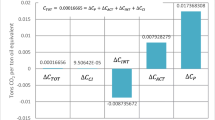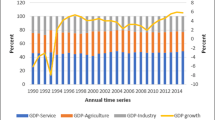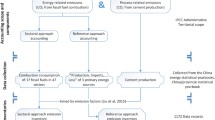Abstract
An extended Kaya identity and the Logarithm Mean Divisia Index approach were applied in this paper to identify, quantify and explain the main factors behind Cameroon’s CO2 emissions before, during and after the economic crisis of the years 1980. The analyses covered the period from 1971 to 2014 and the results showed that: (1) Cameroon’s carbon intensity increased by 75 and 47% during the periods before (1971–1984) and after (1984–1994) the economic crisis, while it decreased significantly by − 135% during the crisis period (1994–2014). At the same time, the country’s emission factor increased by 30% between 2007 and 2014. (2) The effect of the demographic change was the main driver of Cameroon’s CO2 emissions during the periods 1984–1994 and 1994–2014, whereas the effect of economic activity was the main driver of the increase in these emissions between 1971 and 1984. (3) The energy intensity effect contributed to the increase in CO2 emissions during the period 1984–1994 in the same way as the effect of demographic change. However, this factor helped reduce CO2 emissions in the other two periods. (4) Although the effect of substitution of fossil fuels and the effect of renewable energy all contributed to reducing CO2 emissions during the period of this study, we found that the effect of renewable energy behind CO2 emissions remains insignificant compared to the renewable energy potential available in Cameroon. Finally, policy recommendations aimed at enabling Cameroon to achieve its objectives of reducing CO2 emissions were formulated in this article.







Similar content being viewed by others
References
Akram, Z., Engo, J., Akram, U., & Zafar, M. W. (2019). Identification and analysis of driving factors of CO2 emissions from economic growth in Pakistan. Environmental Science and Pollution Research, 26(19), 19481–19489. https://doi.org/10.1007/s11356-019-05281-0.
Ang, B. W. (1995). Decomposition methodology in industrial energy demand analysis. Energy, 20(11), 1081–1095. https://doi.org/10.1016/0360-5442(95)00068-R.
Ang, B. W. (2004). Decomposition analysis for policymaking in energy: which is the preferred method? Energy Policy, 32(9), 1131–1139. https://doi.org/10.1016/S0301-4215(03)00076-4.
Ang, B. W. (2005). The LMDI approach to decomposition analysis: A practical guide. Energy Policy, 33(7), 867–871. https://doi.org/10.1016/j.enpol.2003.10.010.
Ang, B. W., & Choi, K. H. (1997). Decomposition of aggregate energy and gas emission intensities for industry: A refined divisia index method. Energy Journal, 18(3), 59–73.
Ang, B. W., & Lee, S. Y. (1994). Decomposition of industrial energy consumption: Some methodological and application issues. Energy Economics, 16(2), 83–92. https://doi.org/10.1016/0140-9883(94)90001-9.
Ang, B. W., & Liu, F. L. (2001). A new energy decomposition method: Perfect in decomposition and consistent in aggregation. Energy, 26(6), 537–548. https://doi.org/10.1016/S0360-5442(01)00022-6.
Ang, B. W., & Zhang, F. Q. (2000). A survey of index decomposition analysis in energy and environmental studies. Energy, 25(12), 1149–1176. https://doi.org/10.1016/S0360-5442(00)00039-6.
Boyd, G. A., Hanson, D. A., & Sterner, T. (1988). Decomposition of changes in energy intensity: A comparison of the divisia index and other methods. Energy Economics, 10(4), 309–312. https://doi.org/10.1016/0140-9883(88)90042-4.
Boyd, G., McDonald, J. F., Ross, M., & Hanson, D. A. (1987). Separating the changing composition of US manufacturing production from energy efficiency improvements: A divisia index approach. The Energy Journal, 8(2), 77–96.
Cansino, J. M., Sánchez-Braza, A., & Rodríguez-Arévalo, M. L. (2015). Driving forces of Spain׳s CO2 emissions: A LMDI decomposition approach. Renewable and Sustainable Energy Reviews, 48, 749–759. https://doi.org/10.1016/j.rser.2015.04.011.
Cui, E., Ren, L., & Sun, H. (2016). Analysis of energy-related CO2 emissions and driving factors in five major energy consumption sectors in China. Environmental Science and Pollution Research, 23(19), 19667–19674. https://doi.org/10.1007/s11356-016-7081-7.
Dai, S., Zhang, M., & Huang, W. (2016). Decomposing the decoupling of CO2 emission from economic growth in BRICS countries. Natural Hazards, 84(2), 1055–1073. https://doi.org/10.1007/s11069-016-2472-0.
De Freitas, L. C., & Kaneko, S. (2011). Decomposition of CO2 emissions change from energy consumption in Brazil: Challenges and policy implications. Energy Policy, 39(3), 1495–1504. https://doi.org/10.1016/j.enpol.2010.12.023.
Engo, J. (2018). Decomposing the decoupling of CO2 emissions from economic growth in Cameroon. Environmental Science and Pollution Research. https://doi.org/10.1007/s11356-018-3511-z.
Engo, J. (2019a). Barriers related to the deployment of renewable energies in Cameroon and ways to strengthen policies. Resources and Environmental Economics, 1(1), 29–38. https://doi.org/10.25082/ree.2019.01.004.
Engo, J. (2019b). Decomposition of Cameroon’s CO2 emissions from 2007 to 2014: An extended Kaya identity. Environmental Science and Pollution Research. https://doi.org/10.1007/s11356-019-05042-z.
Engo, J. (2019c). Decoupling analysis of CO2 emissions from the transport sector in Cameroon. Sustainable Cities and Society, 51, 101732. https://doi.org/10.1016/j.scs.2019.101732.
Feng, K., Davis, S. J., Sun, L., & Hubacek, K. (2015). Drivers of the US CO2 emissions 1997–2013. Nature Communications, 6, 7714.
GCA. (2019). CO2 territorial emissions in 2013 (MtCO2). Global Carbon Atlas 2013:0–3. Available at: http://www.globalcarbonatlas.org/en/CO2-emissions. Accessed 28 Dec 2019.
Hammond, G. P., & Norman, J. B. (2012). Decomposition analysis of energy-related carbon emissions from UK manufacturing. Energy, 41(1), 220–227. https://doi.org/10.1016/j.energy.2011.06.035.
Hilaire, N., Hervé, K. F., & François, K. (2014). Atmospheric pollution and economic growth in Cameroon. Journal of International Business and Economics, 2(3), 171–187. https://doi.org/10.15640/jibe.v2n3a8.
ICCAM. (2013). OPÉRATION ÉPERVIER:Les Gestionnaires Publics Sous Haute Surveillance. Investir Au Cameroun (ICCAM) (Vol. 13, p. 32). Available at http://www.investiraucameroun.com/pdf/IC13.pdf. Accessed 27 Dec 2019.
IEA. (2017). CO2 emissions from fuel combustion. Oecd/Iea, pp. 1–155.
IEA-CMR. 2020. “Cameroon International Energy Agency Balances.” Available at: https://www.iea.org/countries/non-membercountries/cameroon/.
INDC-CMR. (2015). Republique Du Cameroun Contribution Prevue Determinee Au Plan National (Cpdn) Intended Nationally Determined Contribution (Indc). Population, M W Us, Mds Cpdn, La Industrialis, Nouveau Pays (pp. 1–17). Available at http://www4.unfccc.int/ndcregistry/PublishedDocuments/Cameroon First/CPDN CMR Final.pdf. Accessed 05 Jan 2020.
IPCC. (2014). Climate change 2014: Synthesis report. Contribution of working groups I, II and III to the fifth assessment report of the intergovernmental panel on climate change. https://doi.org/10.1017/CBO9781107415324.004.
İpek Tunç, G., Türüt-Aşık, Serap, & Akbostancı, Elif. (2009). A decomposition analysis of CO2 emissions from energy use: Turkish case. Energy Policy, 37(11), 4689–4699. https://doi.org/10.1016/j.enpol.2009.06.019.
Jahan S. (2016). Human development report 2016 human development for everyone. United Nations Development Project, pp. 1–271.
Jeong, K., & Kim, S. (2013). LMDI decomposition analysis of greenhouse gas emissions in the Korean manufacturing sector. Energy Policy, 62, 1245–1253. https://doi.org/10.1016/j.enpol.2013.06.077.
Karmellos, M., Kopidou, D., & Diakoulaki, D. (2016). A decomposition analysis of the driving factors of CO2 (carbon dioxide) emissions from the power sector in the European Union Countries. Energy, 94, 680–692. https://doi.org/10.1016/j.energy.2015.10.145.
Kaya. (1990). Impact of carbon dioxide emission on GNP growth: Interpretation of proposed scenarios. Paris: Presentation to the Energy and Industry Subgroup, response strategies working group, IPCC. X’Pert Stress PW3208, Software for Residual Stress Analysis, PANalytical, The Netherlands. www.Panalytical.Com. http://www.sciencedirect.com/science/article/pii/S0045782504000313.
Li, W., Li, H., Zhang, H., & Sun, S. (2015). The analysis of CO2 emissions and reduction potential in China’s transport sector. Mathematical Problems in Engineering, 1, 1–12. https://doi.org/10.1155/2016/1043717.
Li, X., Liao, H., Du, Y. F., Wang, C., Wang, J. W., & Liu, Y. (2017). Carbon dioxide emissions from the electricity sector in major countries: A decomposition analysis. Environmental Science and Pollution Research. https://doi.org/10.1007/s11356-017-1013-z.
Liu, X. Q., Ang, B. W., & Ong, H. L. (1992). The application of the divisia index to the decomposition of changes in industrial energy consumption. The Energy Journal, 13(4), 161–177.
Mousavi, B., Neil, S. A., Lopez, J. B., Biona, M., Chiu, A. S. F., & Blesl, M. (2017). Driving forces of Iran’s CO2 emissions from energy consumption: An LMDI decomposition approach. Applied Energy, 206, 804–814. https://doi.org/10.1016/j.apenergy.2017.08.199.
Nasab, E. H., Robab, A., Shermineh, F. D., & Mohammad, A. S. (2012). An analysis of energy consumption in transportation and industrial sectors—A multiplicative LMDI approach with application to Iran. Iranian Economic Review, 16(32), 1–17.
Noubissi Domguia, E., & Njangang, H. (2017). Croissance Économique et Dégradation de l’environnement Au Cameroun: Croissance Économique et Dégradation de l’environnement. African Development Review, 29, 615–629. https://doi.org/10.1111/1467-8268.12300.
O’Mahony, T. (2013). Decomposition of Ireland’s carbon emissions from 1990 to 2010: An extended Kaya identity. Energy Policy, 59, 573–581. https://doi.org/10.1016/j.enpol.2013.04.013.
Obadi, S. M., & Matej, K. (2016). Drivers of CO2 emissions in the Slovak economy: The logarithmic mean divisia index approach of decomposition. Ekonomicky Casopis, 64(4), 331–352.
Peters, G. P., Andrew, R. M., Canadell, J. G., Fuss, S., Jackson, R. B., Korsbakken, J. I., et al. (2017). Key indicators to track current progress and future ambition of the Paris agreement. Nature Climate Change, 7(2), 118–122. https://doi.org/10.1038/nclimate3202.
RECP. (2018). Afria-EU Renewable Energy Programme. Available at https://www.africa-eu-renewables.org/market-information/cameroon/renewable-energy-potential/. Accessed 29 Dec 2019.
Reitler, W., Rudolph, M., & Schaefer, H. (1987). Analysis of the factors influencing energy consumption in industry: A revised method. Energy Economics, 9(3), 145–148. https://doi.org/10.1016/0140-9883(87)90019-3.
Review, Country. (2017). 2017 Country review. Available at http://www.countrywatch.com/Content/pdfs/reviews/B35Z5356.01c.pdf. Accessed 02 Aug 2018.
Roinioti, A., & Koroneos, C. (2017). The decomposition of CO2 emissions from energy use in Greece before and during the economic crisis and their decoupling from economic growth. Renewable and Sustainable Energy Reviews, 76, 448–459. https://doi.org/10.1016/j.rser.2017.03.026.
Román-Collado, R., & Morales-Carrión, A. V. (2018). Towards a sustainable growth in Latin America: A multiregional spatial decomposition analysis of the driving forces behind CO2 emissions changes. Energy Policy, 115, 273–280. https://doi.org/10.1016/j.enpol.2018.01.019.
Shi, Y., Zeng, Y., Engo, J., Han, B., Li, Y., & Muehleisen, R. T. (2020). Leveraging inter-firm influence in the diffusion of energy efficiency technologies: An agent-based model. Applied Energy, 263, 114641.
Sumabat, A. K., Lopez, N. S., Krista Danielle, Y., Hao, H., Li, R., Geng, Y., et al. (2016). Decomposition analysis of Philippine CO2 emissions from fuel combustion and electricity generation. Applied Energy, 164, 795–804. https://doi.org/10.1016/j.apenergy.2015.12.023.
Sun, C., Ding, D., & Yang, M. (2017). Estimating the complete CO2 emissions and the carbon intensity in india: from the carbon transfer perspective. Energy Policy, 109(March), 418–427. https://doi.org/10.1016/j.enpol.2017.07.022.
Transparency International. (2016). Transparency international corruption perceptions index 2016. Transparency International Corruption Perceptions Index 2016 9. Available at http://www.transparency.org/news/feature/corruption_perceptions_index_2016. Accesssed 30 Aug 2018.
UNEP. (2016). Cameroon: Consumption, energy resources, energy. (Table 1):2013–16. Available at https://wedocs.unep.org/bitstream/handle/20.500.11822/20487/Energy_profile_Cameroon.pdf?sequence=1&isAllowed=y. Accessed 03 Jan 2020.
UNFCCC. (2015). Paris Agreement. In Conference of the Parties on its twenty-first session 21932(December), Vol. 32. FCCC/CP/2015/L.9/Rev.1.
Wang, M., & Chao, F. (2017). Decomposition of energy-related CO2 emissions in China: An empirical analysis based on provincial panel data of three sectors. Applied Energy, 190(Supplement C), 772–787. https://doi.org/10.1016/j.apenergy.2017.01.007.
Wang, Q., & Li, R. (2016). Journey to burning half of global coal: Trajectory and drivers of China׳s coal use. Renewable and Sustainable Energy Reviews, 58, 341–346. https://doi.org/10.1016/j.rser.2015.12.104.
WDI. (2019). World Development Indicators|DataBank. The World Bank. Available at http://databank.worldbank.org/data/reports.aspx?source=world-development-indicators#advancedDownloadOptions. Accessed 30 Dec 2019.
Zhang, Y.-J., & Da, Y.-B. (2015). The decomposition of energy-related carbon emission and its decoupling with economic growth in China. Renewable and Sustainable Energy Reviews, 41, 1255–1266. https://doi.org/10.1016/j.rser.2014.09.021.
Acknowledgements
The authors would like to dedicate this work to Mrs. Zeh Engo Seraphine, Mrs Bissa Nti Elise, Mr. Ngbwa Samuel and Mr. Biya Bendele Emmanuel for their multiple support. We would also like to thank all those who are in charge of the scientific evaluation of this work and more particularly Editors and Reviewers.
Author information
Authors and Affiliations
Corresponding author
Ethics declarations
Conflict of interest
The authors declare that they have no conflict of interest.
Additional information
Publisher's Note
Springer Nature remains neutral with regard to jurisdictional claims in published maps and institutional affiliations.
Rights and permissions
About this article
Cite this article
Hossain, M.A., Engo, J. & Chen, S. The main factors behind Cameroon’s CO2 emissions before, during and after the economic crisis of the 1980s. Environ Dev Sustain 23, 4500–4520 (2021). https://doi.org/10.1007/s10668-020-00785-z
Received:
Accepted:
Published:
Issue Date:
DOI: https://doi.org/10.1007/s10668-020-00785-z




